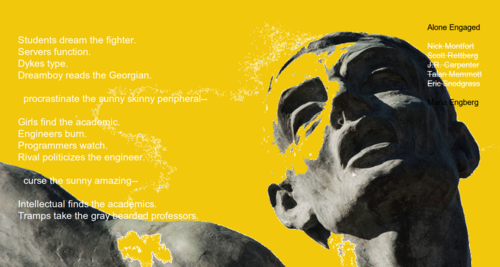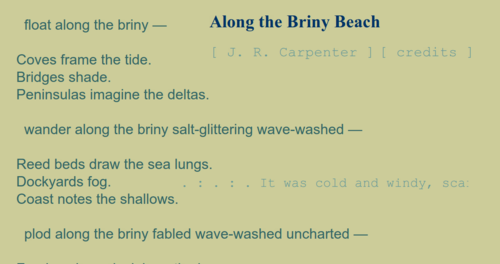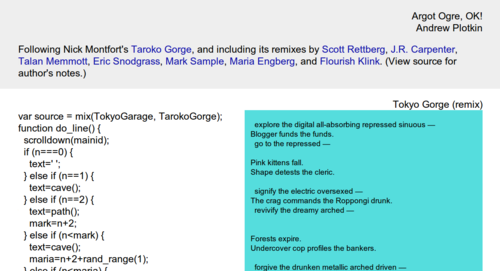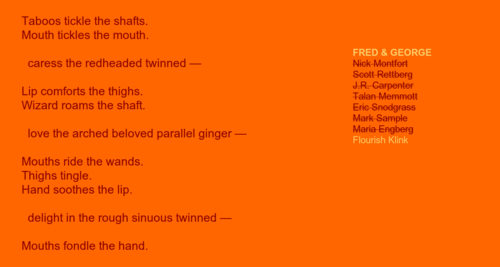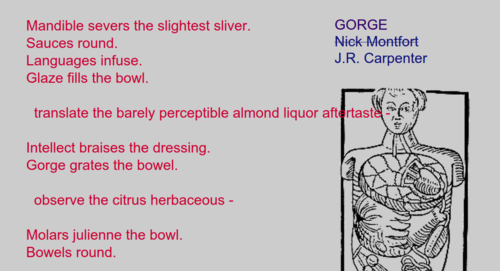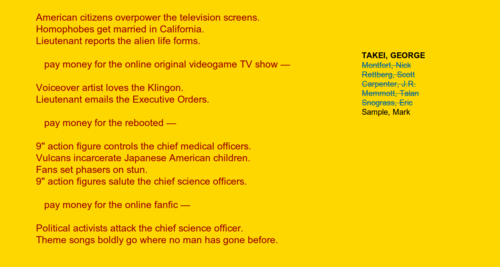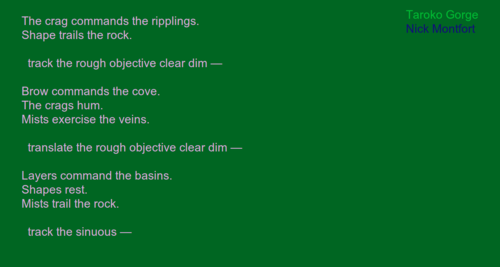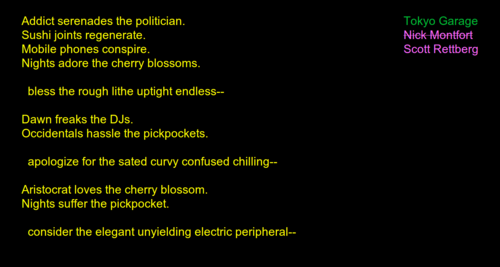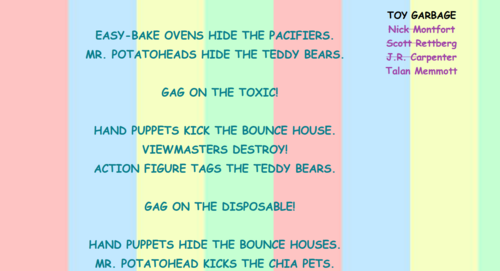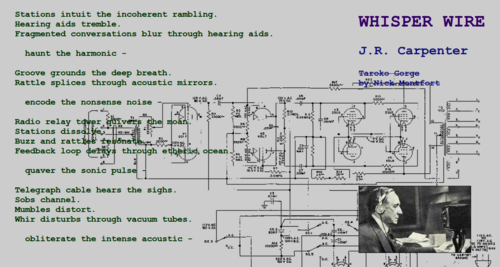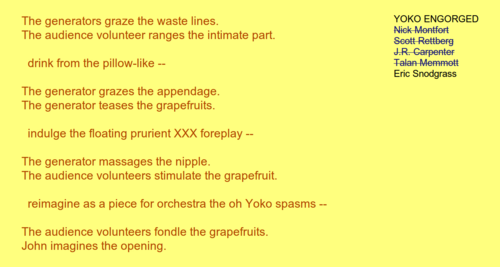Designer Gulch by Brendan Howell is another remix of my oft-remixed poetry generator, Taroko Gorge. This one is installed in the lobby of the Berliner Technische Kunsthochschule.
Yo Dawg, I Hear You Like Taroko Gorge
In his just-released “Argot Ogre, OK!” Andrew Plotkin presents mash-ups and remixes of (almost) all the “Taroko Gorge” remixes to date (and of course the original “Taroko Gorge”), producing such poignant lines as “LAWN DARTS linger” along with single-source remixes and some different stanza shapes. Anyone interested in this thread of poetry generation projects should check it out and should certainly “view source.” Or don’t, if you don’t want to discover more about the secret of the monkey.
This, my friends, calls for a recap of the generators of this general sort to date – eleven of them, so far. Note particularly the two generators mentioned only in comments (“Whisper Wire,” a third remix with visual elements by J. R. Carpenter and the fanlicious “Takei, George” by Mark Sample, which was released after my post) and two other generators released after my post (“Alone Engaged” by Maria Engberg, made at and perhaps redolent of Georgia Tech, and a generator for the the Harry Potter wizarding world of Weasleycest, “Fred & George” by Flourish Klink). In alphabetical order by title, here is a linked list of all of them so far:
Winter in Brazil, Southern Edition
Like my collaborator Noah Wardrip-Fruin, I have come to Brazil for the winter. But not to a nice warm part of Brazil — I’m in Passo Fundo, in the far South, at the 14th Jornada Nacional de Literatura. Here, it has been cold outside, but there has been great excitement about writing and literary art.
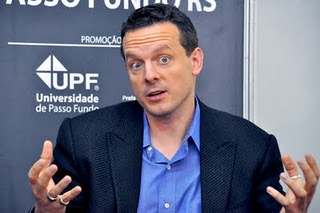
I have been correctly identified as a space man as I’ve shown and discussed interactive fiction, poetry generation, and other forms of electronic literature.
I gave a longer talk this morning about these topics, which was translated into Brazilian Portuguese as I spoke. Tomorrow, I will speak on a panel in the main tent to about 5000 people about certain types of “convergence” in writing and literature. The type I will address is a convergence between authors – collaboration.
Generador de la Historia “The Two” en Español
Thanks to Carlos León, there is now a Spanish version, “Los Dos,” of my simple but (I think) provocative story generator “The Two.” The system was previously translated into French as “Les Deux” by Serge Bouchardon.
Stop by and check them out; all three are available in JavaScript versions that run right away in a browser. For those who are interested, the original Klingon, er, Python, is also available for each of the three languages.
The reader who takes the time to try to actually understand the output and resolve the pronouns in it will see that often this task is complicated by ambiguity in gender, although syntax and power relations also work to suggest certain ways that pronouns can be resolved. The need to leave the gender of the characters indeterminate in the first line posed particular problems, and slightly different problems, for the French and Spanish translators, who each found a solution.
Rettberg on After Parthenope
If you’re interested in story generation or Processing, do check out Scott Rettberg’s new screencast describing the process he undertook in writing and programming After Parthenope. He goes through the nuts and bolts of the piece and how it rolls out language using a hand-crafted trigram model; he also explains some of the pleasures of authoring a system like this.
Colloquium Past, Conference to Come in Mexico
I’ve recently returned from a great trip to Mexico City. I was at the 5th Mexican International Colloquium on Computational Creativity presenting alongside two other foreign guests, Graeme Ritchie and Dan Ventura, and two local researchers, Rafael Pérez y Pérez and Eduardo Peñaloza. There was a productive and lively roundtable on interdisciplinary work and collaboration the day before the talk, too. Rafael Pérez y Pérez, a collaborator of mine, arranged the colloquium and was a very gracious host, making sure that we got to and from the airport, to all of the colloquium events, and to several excellent meals.
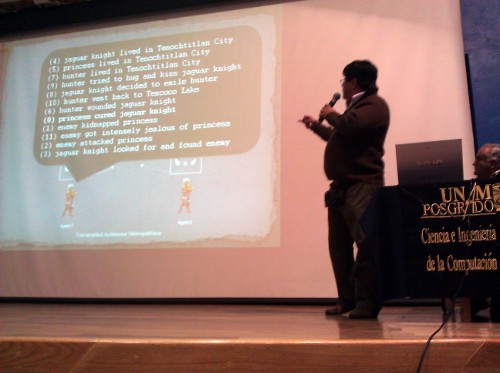
I have a few things to mention about the 5th MICCC, but I’d like for this post to be mainly forward-looking rather than backward-looking. That’s because ICCC-11, the 2011 International Conference on Computational Creativity, is an event on the same topic as this recent colloquium, and it will be taking place in the same city thanks to the local organizing work of our wonderful host, Rafael. Although the colloquium was intellectually rich and I enjoyed visiting Mexico City for its own sake, I was also very pleased because I was anticipating this larger-scale academic gathering that will be taking place April 27-29. In part, I was reminded of the conference because I and the other organizers, Rafael, Graeme, and Dan, spent a good bit of the time working to make the remaining decisions and to prepare for ICCC-11. But even just walking around the city, I had in mind how much other computational creativity researchers would enjoy coming to México.
At the colloquium, I was the only one who didn’t discuss a large-scale system that is somehow related to the creative process. (I do have a such a system, Curveship, but I wanted to focus on something else in this talk.) I spoke about creative computing and the relationship that this area has to computational creativity. In creative computing, the computer is seen as a medium and platform for human creative work. There’s a strong relationship between this area and computational creativity, but there are some distinctions, too. I spoke about a very short, simple Commodore 64 BASIC program:
10 PRINT CHR$(205.5+RND(1)); : GOTO 10
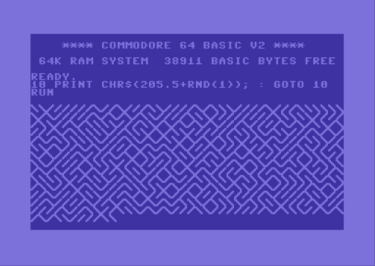
This one-line program is the focus of a deep investigation that I am undertaking with nine other authors. We plan for this study to result in a single-voice academic book – not an edited collection, not a “chapter book” with separately authored segments, but something that reads like a single-author book but is written by ten people. We are still in the early stages of writing this book, but it’s our hope that 10 PRINT CHR$(205.5+RND(1)); : GOTO 10 by Nick Montfort, Patsy Baudoin, John Bell, Ian Bogost, Jeremy Douglass, Mark Marino, Michael Mateas, C. E. B. Reas, Mark Sample, and Noah Vawter will be published by the MIT Press in 2012. (Yes, the book’s title is the program itself.) Since the colloquium focused on interdisciplinary work and collaboration, this seemed like a nice project to discuss, even though the ten of us working on this project are not trying to model the creative process using computation. I described how the study of this program shed additional light on the relationship between platform and creativity, and how it suggested that computational creativity models try to take into account that relationship.
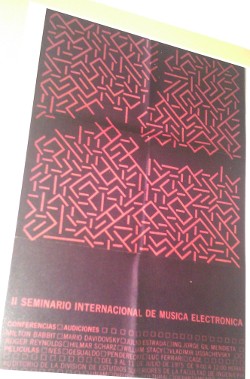
The other talks offered some excellent descriptions of and discussions of computational creativity systems: MEXICA, DARCI, and STANDUP (along with its predecessor, JAPE). These systems, and the things that have been done with them, are all great examples of creative computing, by the way, in addition to being computational investigations of creativity! I could do a post this long covering just the new thoughts that have come to me about these projects, each of which I knew about before. For now, I’ll refer you to the abstracts and links for more on those projects.
Coming up: The 2011 International Conference on Computational Creativity, April 27-29 in Mexico City
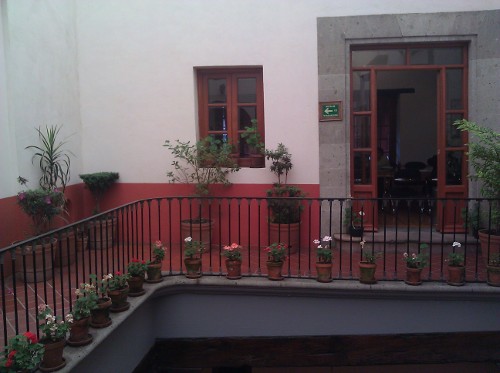
I’ve been to Mexico City before, but this was my first trip to the city’s main square, the Zócalo. This is the area where ICCC-11 will take place. It’s an amazing sight. You can see that Mexico City is mind-bogglingly big as you fly in, but the Zócalo is massive in a different way. The plaza and the area is human-scale (designed for pedestrians and very walkable, with many shops and restaurants) while also being tremendous and impressive. On the north is the cathedral; the National Palace, where President Calderón works, is to the east. An enormous Mexican flag flies from the National Palace during the day. To the west are several buildings, including the Best Western Majestic Hotel, which will be offering a discounted rate for ICCC-11. Just off the plaza, between the Cathedral and the National Palace, is where ICCC-11 will be held – at La Casa de la Primera Imprenta. The first printing press in the Americas was installed in 1536 in this building. It now offers a conference facility of just the right size for ICCC-11 presentations and demos, several galleries, and a bookstore.
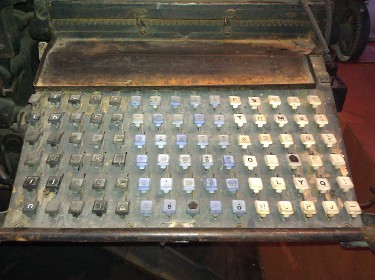
The Autonomous Metropolitan University, Cuajimalpa is the host institution for ICCC-11, which is also supported by UNAM’s postgraduate program in computer science and engineering. The colloquium that UAM-Cuajimalpa put on with UNAM was well-attended by students and faculty who had some good questions for us. I know that we will have great local arrangements for ICCC-11; the participation we had in the colloquium suggests that we will be part of some good conversations (and, no doubt, see some good presentations and demos) from local ICCC-11 attendees.
So, I hope to see you readers who work in computational creativity in Mexico City at the end of April. I’m the publicity chair for ICCC-11, but in addition to publicizing the conference, I’m glad to email with anyone who has questions about the conference or about visiting Mexico City. And, remember that the deadline for submissions (of short papers, long papers, or show-and-tell proposals) is December 13, less than a month away now: The call for papers has the details, and there is more information on other parts of the ICCC-11 site.
ELO_AI at Brown Wraps Up
The Electronic Literature Organization‘s conference at Brown University has new concluded – the workshops, performances, screenings, exhibits, and sessions all went very well, as did the coffee breaks and other times for informal conversation. Many thanks to the organizer of ELO_AI (Archive & Innovate), John Cayley!
The conference was a celebration of and for Robert Coover, co-founder of the Electronic Literature Organization and major American novelist, whose teaching and promotion of electronic literature has been essential to the field. Robert Coover was toasted and at least lightly roasted, heard papers presented on his work, and did a reading of the “recently renovated Hypertext Hotel” – a famous early project by students which did indeed turn out to have some recent renovations.
ELO_AI began on Thursday with an array of workshops by Damon Loren Baker, John Cayley, Jeremy Douglass, Daniel Howe, and Deena Larsen. Deena Larsen was later part of a great roundtable on archiving with Will Hansen, Marjorie Luesebrink, and Stephanie Strickland; the group discussed Duke University’s work with Stephanie Strickland’s papers (and digital works), the Deena Larsen Collection at the University of Maryland, and the efforts that the ELO made in the Preservation, Archiving, and Dissemination project. On the first day of the conference, Mark Marino organized a great panel with four undergraduate presenters. And, there was an opening reception at the Westminster Street gallery where an excellent show of digital literary work has been put together. While there was an array of work (in the screenings, performances, gallery, and sessions) from people who were presenting at an ELO conference for the first time, I was also glad to see many of the people who were instrumental in creating and publishing literary work on the computer more than a decade ago.
Without trying to enumerate every session of the conference, I’ll mention the Sunday 10am plenary to try to get across how wide-ranging the presentations and presenters were. In this session, George Landow, author of the famous Hypertext: The Convergence of Contemporary Critical Theory and Technology (1992), told the tragicomical tale of hypertext’s use in education at Brown. Angela Chang and Peggy Chi described two interactive projects for very young readers, projects that used my Curveship system and the Open Mind Common Sense project from Henry Lieberman’s MIT Media Lab group. Lawrence Giffin used the not-very-democratic framework of the salon to consider the important avant-garde site Ubuweb. And finally, Paola Pizzichini and Mauro Carassai looked into the Italian edition of Michael Joyce’s Afternoon and its almost total absence from Italian libraries. Certainly, some sessions were more focused – very focused in the case of the one on William Poundstone’s digital writing work; at least with a theme of process intensity, in the case of the session were I presented my work on Adventure in Style. But we had a genuinely diverse group of presenters, and sessions like this one on Sunday revealed this, while also showing that we do have cross-cutting interests and that we can have valuable conversations.
A special area if interest for me, interactive fiction, was represented by Aaron Reed, who did a reading of his Blue Lacuna in which he deftly showed both interactive sessions and the underlying Inform 7 code while a volunteer interactor spoke commands. Aaron Reed also gave a paper on that large-scale piece, explaining his concept of interface and his work on developing a non-player character who ranged across different spaces without being a simple opponent or companion character. In the same performance session and paper session, I got to see and learn more about Fox Harrell’s Living Liberia Fabric, a piece produced in affiliation with the Truth and Reconciliation Commission (TRC) of Liberia, incorporating video testimony, and employing Fox Harrell’s GRIOT system for poetic conceptual blending.
We welcomed new ELO board members and officers. Joining the ELO board are Fox Harrell, Caroly Guertin, and Jason Nelson. Dene Grigar took office as vice president, and Joe Tabbi completed his term as president, handing that role over to me.
During the sessions, we heard critical perspectives on many particular electronic literature work and some on the ELO itself, which will help us think about the challenges the Organization faces and how we can better serve readers and writers beyond American universities. The ELO has had ten years of growth and learning by now, and while there will be more of each to do, our four main projects are now well enough established that all of them are past 1.0:
- The Electronic Literature Collection, the second volume of which has been edited and produced by an independent editorial collective and will be published soon.
- The Electronic Literature Directory, which in its new manifestation offers community-written descriptions as well as metadata.
- Our conference – this most recent one at Brown was our fourth international gathering.
- Our site and our online communications, which offer information about the ELO and an introduction to electronic literature.
I’m glad to be starting my service as president of the ELO at a time when the organization has just had a very successful conference and has these other effective projects rolling. Thanks to Joe Tabbi and other past presidents and directors of the Organization for bringing us to this point – and, again, to John Cayley for bringing us all together at Brown.
Once More into the Gorge
J.R. Carpenter has taken apart and reassembled my poetry generator Taroko Gorge. (The first to appropriate and rework that piece, as far as I know, was Scott Rettberg, who created Tokyo Garage.) J.R.’s piece – one might call it a tract of sorts – is simply called Gorge. (Update: J.R. has a post discussing Gorge, too.) See if you can stomach it, and for how long.
Also, check out J.R.’s project Story Generation(s), which involved reworking two of my 1k Python programs and which launched May 8 at PW10 Performance Writing Weekend. The project includes a JavaScript port of “Excerpts from the Chronicles of Pookie & JR.” This is generally not a bad idea; I wrote Taroko Gorge originally in Python (a programming language I prefer for when I’m thinking) and converted it to JavaScript for easy web viewing.
“Geração sobre a fala” / “My Generation about Talking”
“Geração sobre a fala” (“My Generation about Talking,” Nick Montfort) Tradução para o português, Cicero Inacio da Silva.
“My Generation about Talking,” a text generator which I first presented at the Software Studies Workshop on May 21, 2008, is now available in Portuguese translation, thanks to Cicero Inacio da Silva. It was made for use in a presentation, but the program is set up to allow a user to play the entire presentation or to access any of the fifteen individual voices, each of which affirms repeatedly in some way.
The program is in Python and will run from the command line in OS X and on many Linux systems. It will run on Windows after Python for Windows has been installed.
For instance, to run the English version of this program on OS X:
- Download yes_voices.py to the desktop; if you download it to another location, move the file to the desktop.
- Start the Terminal application and open a terminal window. An easy way to do this: Click on the Spotlight magnifying glass in the upper left, type “terminal”, and select the Terminal application. A window will open.
- In the terminal window, type “cd Desktop” and press return to change directories to the desktop.
- Type “python yes_voices.py” and press return.
“Les deux” / “The Two”
[English follows…]
Mon générateur d’histoires “The Two” est désormais en ligne avec une traduction française, “Les deux” , de Serge Bouchardon. La version anglaise était auparavant disponible en Python. C’était le second de trois générateurs de 1k que j’avais réalisés à la fin de 2008. “Les deux” génère des histoires toutes simples de trois lignes, mais dont l’effet de sens n’est peut-être pas si simple. Les versions anglaise et française sont à présent disponibles en JavaScript et sont ainsi facilement accessibles sur le Web.
My story generator, “The Two,” is now online along with a French translation, “Les deux,” by Serge Bouchardon. The English version of the story was previously available in Python. It was the second of three 1k story generators that I wrote near the end of 2008. “The Two” generates three-line stories in a straightforward way, although the effect may not be straightforward. Both French and English versions are now available in JavaScript, so they can be run from the Web easily.
Literary Generation at DAC
Late yesterday, I wrapped up my long (and very fun) day at Digital Arts and Culture 2009 in Irvine by presenting my paper “The ppg256 Series of Minimal Poetry Generators” in the late afternoon cognition and creativity panel and then by being a part of the extraordinary DAC Literary Arts Extravaganza, quickly presenting selections that I called “Five Uneasy Pieces:”
- “The Purpling,” a prose poem in hypertext
- The Marble Index (a work in progress in the interactive fiction system Curveship)
- “Taroko Gorge,” a poetry generator originally written in 1k of Python
- “The Two,” a 1k Python story generator (on the screen, I premiered the French translation by Serge Bouchardon – links to both coming soon)
- “ppg256-2,” one of my 256-character Perl poety generators which my paper discusses
Story Generation with Pookie and JR
Excerpts from the Chronicles of Pookie & JR:
Previously, Pookie and JR had only ever met at parties.
For the first few nights, Pookie and JR keep to their corners.
JR changes Pookie’s water. Pookie makes a mess of his feeding dish.
JR cooks slowly, foraging in this strange kitchen.
Tonight’s dinner puts one withered leek out of its misery.
JR hasn’t been sleeping much lately.
Pookie keeps his thoughts to himself.
To be continued…
J. R. Carpenter, author of Words the Dog Knows, Entre Ville, The Cape, and other fine works of e-lit, print, and xerography, has delightfully repurposed one of my 1k story generators to have it tell stories involving her and a hermit crab named Pookie. The program has grown to about 2k, but it uses the same simple (and surprisingly effective) method as my first generator does: It simply removes all but 5-9 sentences from a sequence, eliding some of what’s been written. Sometimes the reader is left to wonder who the hermit is. Here’s a direct link to the Python code for the program, and here’s the page on Excerpts from the Chronicles of Pookie & JR.
Rafael Pérez y Pérez to Speak at MIT
Next week, the Purple Blurb series offers a second special summer talk by a leading researcher in creative text generation. Rafael Pérez y Pérez will speak on …
MEXICA: A Computer Model for Plot Generation of Prehispanic Stories
MEXICA is a computer model that generates plots for short stories about the Mexicas, the old inhabitants of what today is México City, based on the engagement-reflection cognitive account of writing. During engagement MEXICA generates material guided by content and rhetorical constraints, avoiding the use of explicit characters’ goals or story-structures. During reflection the system breaks impasses, evaluates the novelty and interestingness of the story in progress and verifies that coherence requirements are satisfied. In this talk I will explain the main characteristics of the system, I will show how emotions are employed to progress a story in a coherent way and generate novel situations, and how the dramatic tension of the story in progress might be employed to evaluate its interestingness. I will present results showing how story generation is affected by various model parameters and I will compare MEXICA with other story-generators programs. Finally, I will mention how we are employing MEXICA as starting point for new research projects.
Pérez y Pérez will speak on Wednesday July 15, 6pm-7pm, at MIT in room 14E-310. This is in the same location as Pablo Gervás’s talk in May, and just one more floor up the stairs from the Trope Tank, where other Purple Blurb events were located. The talk is (as with all Purple Blurb presentations) open to the public.
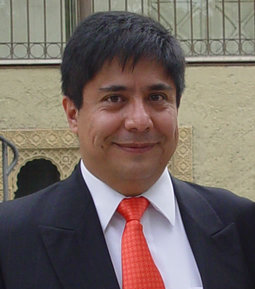
Rafael Pérez y Pérez earned a BSc. in Electronics and Computers at Universidad Iberoamericana in México City, a MSc. in Knowledge Based Systems and a DPhil. in Artificial Intelligence at Sussex University in England. His research has focused on computer models of creativity. He and his students have developed programs that write short stories, compose music, and solve geometry problems, among other things. In 2006 he organised the Mexican Creativity, Cognition and Computers research group (MCCC) which aims to gather together a multidisciplinary group of researchers and students interested in computational creativity. He has published different papers in the area and has participated as a PC member and co-chair in international events related to computational creativity. Currently he is a researcher and lecturer at The Autonomous Metropolitan University (Universidad Autónoma Metropolitana or UAM) in México City and an invited Lecturer in the MSc and PhD programs in Computer Science at The National Autonomous University of México (Universidad Nacional Autónoma de México or UNAM).
Pablo Gervás to Speak at MIT
Next week, the Purple Blurb series offers a special talk by a leading European researcher in creative text generation.

Pablo Gervás works as associate professor (profesor titular de universidad) at the Departamento de Ingeniería del Software e Inteligencia Artificial, Facultad de Informática, Universidad Complutense de Madrid. He is the director of the NIL research group and also of the Instituto de Tecnología del Conocimiento.
His research is on processing natural language input, generating natural language output, building resources for related tasks, and generating stories. In the area of creative text generation, he has done work on automatically generating metaphors, formal poetry, and short films.
He will speak on Wednesday May 20, 6pm-7pm, at MIT in room 14E-310. The talk is (as with all Purple Blurb presentations) open to the public, and (as with all Purple Blurb presentations so far) will be in English.



